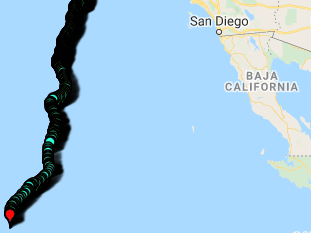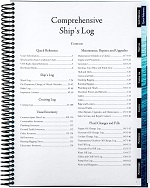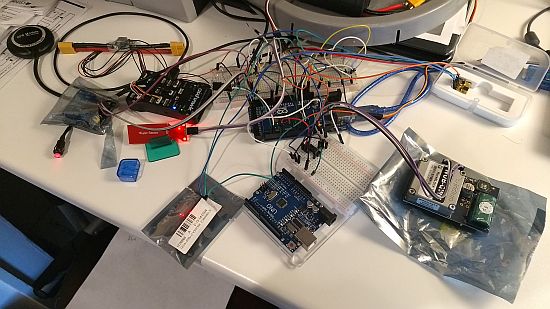LAUNCHED! Sort of.
LoCARB was launched July 27th 2020 at 10:00 am PST in Half Moon Bay Ca. We packed up the family and loaded up the boat at 8:30am and arrived at Pillar Point Harbor just after 9am. Some testing and photo ops later, we loaded LoCARB in Bare Bones (Kerry’s boat) and headed about 1 mile out from the harbor just past the kelp beds and reef. LoCARB was tested for satellite functionality, electronics box sealed, and the boat placed into the water.
The Fam
Kerry and I
LoCARB loaded into Bare Bones
On the way out of the harbor
Boat in the water, and off without a hitch!
We followed the boat a while just to make sure it was tracking correctly, which was an amazing thing to witness as it was the first time I got to see how it performed up close when larger swells would come. Granted, the swells were not any higher than 2 feet, but it gave me an idea of what LoCARB could handle.
After following the boat a little ways, we headed back and I began to track the boat remotely.
Houston, we have a problem.
LoCARB was tracking and performing beautifully, averaging about 1.8 to 2 knots, and charging well despite being overcast. Feeling relieved, I settled into my new backyard shed and began to write this blog post.
However, after around 6 miles out, LoCARB decided to drift, which caused me concern as I noticed that the RPM went from a nominal 1040-1300 RPM to around 4700+ RPM.
The RPM of 4000+ is typical of the motor under no load at all (free spinning in the air). My immediate assumption was “oh no, someone pulled the boat out of the ocean!” But I decided to wait for a few more updates to see what kind of trajectory it would take.
My heart sank as I realized that the boat was just drifting and that the motor was spinning freely. Since the capsize count was not incrementing, I knew the boat had not flipped upside down with the prop suspended in the air.
A chain of assumptions
So putting on my thinking cap, I arrived at several conclusions:
Assumption 1:
The motor is not meeting any water resistance.
Conclusions based on assumption 1:
- The propeller blades have broken off as its a cheap ebay propeller
- The propeller shaft has broken
- The prop adapter holding the propeller to the shaft has come loose and has fallen off
In my mind, these were the only reasons the boat would report a free spinning motor condition
So a few texts messages and a gas run later, Kerry, Bare bones, and a few of Kerry’s friends embarked on operation rescue LoCARB.
I cant begin to express the gratitude of my new friends who have so willingly contributed their time and energy to this project. I couldn’t have imagined such willingness for people to go so far out of their way for a stranger.
Being that we “sped” along at around 6 knots, it took us about 1 hour to get to LoCARB. Thankfully we had strong cell reception and were able to get updated location updates from LoCARB every 30 minutes.
As we pulled up to grab LoCARB, we noticed the huge amount of jellyfish that were floating around, I knew then the propeller had hit a jellyfish and potentially broken something. It was such that we couldn’t hold onto the hull bottom of LoCARB without a jellyfish coming up and touching our hand. Upon closer inspection I saw a jellyfish tentacle hanging from the propeller. My heart sank at two things at that moment. One, since the prop adapter and propeller were still attached, that meant that the none of the conclusions from assumption 1 were correct. Instead, I assumed the magnetic coupling may have failed, again (assumption 2).
After loading the boat onto Bare Bones, I hand tested the propeller taking care to diagnose any issues. It felt fine. If you slowly turn the propeller when the magnetic coupling is functioning correctly, you will feel the subtle magnetic “notches” of the RC motor when it is turned. I felt that. Feeling no obvious resistance or strange movement and hearing no strange noises, I thought that maybe the magnetic motor coupling had decoupled from its counterpart which would cause the free spinning condition, and maybe nothing was wrong.
Confirmation of assumption 2?
Hopeful, I ripped open the electronics compartment and reinitialized LoCARB, delighted that the prop began to spin again! I was confident that the only issue was the un-syncing of the magnetic coupling.
However, when placing LoCARB back into the water, the prop acted like it was slipping again and the motor began to make a noise with no rotation of the propeller. My conclusion was that the magnetic coupling had failed and had let go of the prop shaft which would cause what we were seeing.
In defeat, I called it quits and had a really tough ride back to the harbor. The boat and my craftsmanship had failed…again (or so I thought). I wasn’t sure if LoCARB would ever be finished. I felt really defeated and frustrated at the thought of having to fix the boat again.
Testing Assumption 2
Upon returning home, I frustratingly drilled a 2″ hole into the rear cone to begin work on cutting open the magnetic coupling again. However, on a fluke I decided to test the coupling one last time.
Everything checked out OK. What the…
I even stopped the prop with a piece of foam and used a glove to hold onto the nose cone of the prop adapter to test for rotational torque. Everything seemed in good order. The magnetic coupling was still 100% functional.
This confused me. Everything suggested that the shaft had let go from the mag coupling and was free spinning. I then decided to test for this. If the shaft was loose, I should be able to pull it straight out. I was unable to.
The magnetic coupling was 100% functional.
So what was different about the initial launch, and the second time you tried to place the boat back into the water?
When LoCARB was launched, it was launched with a slightly undercharged battery and as such, the RPM of the propeller was low enough where it did not decouple completely from the prop assembly. However, during relaunch, the boat had a full days worth of charging and it was currently charging at ~14v. Thats a difference of almost 600-700 RPM out of water. I am confident that the increased RPM of the propeller meeting the resistance of the water caused the slippage and decoupling to occur vs the first launch.
Assumption 3: My sucking at building things
While building the boat, I realized I suck. I suck at making things and I suck at building things with precision. Don’t get me wrong, this isn’t a pity party but its just one of the additional assumptions which made me go get LoCARB from the ocean.
Seeing the motor problem through the lenses of assumptions 1-3, my conclusions were sure to be wrong. I had such low faith in my boat building skills, the thought that it could have just been an issue where the motor and propeller magnetic coupling just decoupling when it hit an object was unfathomable.
But that’s exactly what it was.
The real slim shady
You’re probably reading this like, what the heck are you talking about. Just get on with it already. What was the problem?
The magnetic coupling just decoupled.
Instead of restarting the motor remotely like I should have done, viewing the problem with bad assumptions kept me from seeing the issue for what it was and applying a similarly simple fix.
When programming the motor monitoring function into LoCARB, I only assumed that the propeller would enter into a stall state if it met with too much resistance. I assumed it would never decouple and cause a free spinning condition (assumption number 4). This was supported by the simple test of me holding the propeller stationary when trying to start the motor. When doing so, the motor would try three times, realize it wasn’t spinning, then the ESC would power it off. I was happy with that as the magnetic coupling holding strength is strong enough to stall the motor. I then assumed this would be the case in all running conditions. If I did test for sudden stoppage of the propeller when running at full speed, it probably would have decoupled and I would have seen the dynamic I saw happen with LoCARB 6 miles off the coast. I just never tested for that because of assumption 4.
What are you going to do about it now?
This is literally an 11 character programming fix.
|
1 2 3 4 5 |
FROM THIS: if (rpm <= 50) TO THIS: if (rpm <= 50 or rpm >= 2000) |
In my motor monitoring function I only tested for stalls and not a free running condition. By sensing if the motor is running at an RPM consistent with slippage (anything above ~1500 under load), it will stop the motor and restart the motor to re-sync the coupling.
What I learned
This project is filled with tough lessons, really. This lesson was one about assumptions.
- I’m not as bad of a builder as I thought, the boat is 100% OK.
- The second attempt at the magnetic coupling works and is seemingly durable.
- A bunch of wrong assumptions led to a 2-3 hour recovery trip, an unnecessary 2″ hole in my boat, and a launch day failure. This could have been avoided.
- The error component for this episode was not the boat. It was me. I was the weakest link. I bet if I had just restarted the motor, it would have continued on its journey (I would have to manually restart the motor every time this happened again though).
Now what?
Now with all this behind me I need to patch up the hole with more fiberglass and upload the new programming. I estimate to relaunch LoCARB within a week.















I saw the boat on the beach at HMB just north of the public access stairway on aug 1.